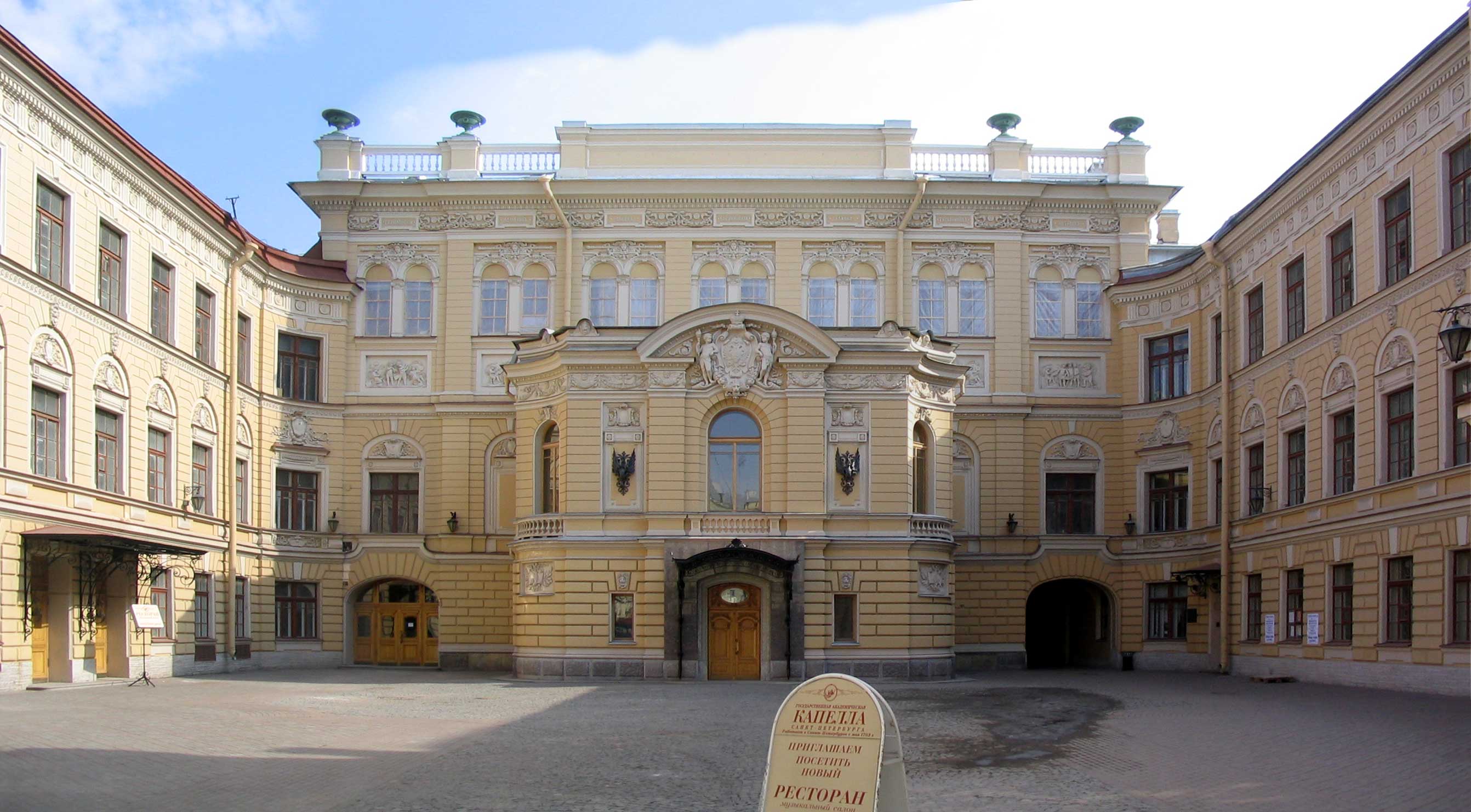|
Yellow Bridge
The Pevchesky Bridge (russian: ą¤ąĄ╠üą▓č湥čüą║ąĖą╣ ą╝ąŠčüčé; literally Singers' Bridge), also known as the Choristers' Bridge or Yellow Bridge (ą¢čæą╗čéčŗą╣ ą£ąŠčüčé, Zholtyi Most), is a single-span bridge across the Moika River in Saint Petersburg, Russia. The bridge is a part of the Palace Square. The length of the bridge is 21 metres, and the width is 72 metres. It is the third-widest bridge in Saint Petersburg, after the Blue Bridge and Kazansky Bridge. Before the February Revolution, the term "ChoristersŌĆÖ Bridge" was shorthand for the tsarist foreign ministry, just as the French foreign ministry is known as the Quai d'Orsay. The first wooden bridge on the site was designed by the French architect Auguste de Montferrand; it was inaugurated in 1834. The first pedestrians to cross the bridge were the troops marching to the parade celebrating the unveiling of the Alexander Column (also designed by Montferrand). [...More Info...] [...Related Items...] OR: [Wikipedia] [Google] [Baidu] |
Georg Von Cancrin
Count Georg Ludwig Cancrin (russian: ąĢą│ąŠčĆ ążčĆą░ąĮčåąĄą▓ąĖčć ąÜą░ąĮą║čĆąĖąĮ, tr=Egor Francevi─Ź Knkrin; 16 November 1774 ŌĆō 10 September 1845) was a Russian German aristocrat and as a politician best known for spearheading reforms in the Russian financial system early in the 19th century. Biography Cancrin was born in Hanau. In 1797, at the age of 23, Cancrin accompanied his father, the mineralogist Franz Ludwig von Cancrin, to Russia, joining the imperial service and changing his name to Georg. In 1823, at the age of 49, Cancrin was appointed Minister of Finance and held that office for 21 years. As a politician, Cancrin was a conservative who opposed the construction of railways and the emancipation of the serfs. Cancrin died in Pavlovsk. Legacy In 1827, Cancrin wrote Alexander von Humboldt, the famous Prussian scientist, asking if he would visit Russia at the monarchy's expense to identify areas where Russia could develop economically. Although Russia had played a m ... [...More Info...] [...Related Items...] OR: [Wikipedia] [Google] [Baidu] |
Bridges Completed In 1840
A bridge is a structure built to span a physical obstacle (such as a body of water, valley, road, or rail) without blocking the way underneath. It is constructed for the purpose of providing passage over the obstacle, which is usually something that is otherwise difficult or impossible to cross. There are many different designs of bridges, each serving a particular purpose and applicable to different situations. Designs of bridges vary depending on factors such as the function of the bridge, the nature of the terrain where the bridge is constructed and anchored, and the material used to make it, and the funds available to build it. The earliest bridges were likely made with fallen trees and stepping stones. The Neolithic people built boardwalk bridges across marshland. The Arkadiko Bridge (dating from the 13th century BC, in the Peloponnese) is one of the oldest arch bridges still in existence and use. Etymology The ''Oxford English Dictionary'' traces the origin of the wo ... [...More Info...] [...Related Items...] OR: [Wikipedia] [Google] [Baidu] |
Bridges In Saint Petersburg
There are more than 342 bridges in the city limits of Saint Petersburg, Russia. This is a partial list of the most famous ones. Peter the Great was designing the city as another Amsterdam and Venice, with canals instead of streets and citizens skillful in sailing. Initially, there were only about ten bridges constructed in the city, mainly across ditches and minor creeks. By Peter's plans, in the summer months, the citizens were supposed to move around in boats, and in the winter months when the water froze to move in sledges. However, after Peter's death, new bridges were built, as it was a much easier way of transportation. Temporary ponton bridges were used in the summertime. The first permanent bridge of bricks and stones across the main branch of the Neva river appeared in 1850. Today, there are more 342 bridges over canals and rivers of various sizes, styles and constructions, built at different periods. Some of them are small pedestrian bridges, such as Bank and Lion bridge ... [...More Info...] [...Related Items...] OR: [Wikipedia] [Google] [Baidu] |
Vasily Stasov Buildings And Structures
Vasili, Vasily, Vasilii or Vasiliy (Russian: ąÆą░čüąĖą╗ąĖą╣) is a Russian masculine given name of Greek origin and corresponds to ''Basil''. It may refer to: *Vasili I of Moscow Grand Prince from 1389ŌĆō1425 * Vasili II of Moscow Grand Prince from 1425ŌĆō1462 *Vasili III of Russia Tsar from 1505ŌĆō1533 *Vasili IV of Russia Tsar from 1606ŌĆō1610 *Basil Fool for Christ (1469ŌĆō1557), also known as Saint Basil, or Vasily Blazhenny *Vasily Alekseyev (1942ŌĆō2011), Soviet weightlifter *Vasily Arkhipov (1926ŌĆō1998), Soviet Naval officer in the Cuban Missile Crisis *Vasily Boldyrev (1875ŌĆō1933), Russian general *Vasily Chapayev (1887ŌĆō1919), Russian Army commander *Vasily Chuikov (1900ŌĆō1982), Soviet marschal *Vasily Degtyaryov (1880ŌĆō1949), Russian weapons designer and Major General *Vasily Dzhugashvili (1921ŌĆō1962), Stalin's son *Vasili Golovachov (born 1948), Russian science fiction author *Vasily Grossman (1905ŌĆō1964), Soviet writer and journalist *Vasily Ignatenko (1961ŌĆō198 ... [...More Info...] [...Related Items...] OR: [Wikipedia] [Google] [Baidu] |
List Of Bridges In Saint Petersburg
There are more than 342 bridges in the city limits of Saint Petersburg, Russia. This is a partial list of the most famous ones. Peter the Great was designing the city as another Amsterdam and Venice, with canals instead of streets and citizens skillful in sailing. Initially, there were only about ten bridges constructed in the city, mainly across ditches and minor creeks. By Peter's plans, in the summer months, the citizens were supposed to move around in boats, and in the winter months when the water froze to move in sledges. However, after Peter's death, new bridges were built, as it was a much easier way of transportation. Temporary ponton bridges were used in the summertime. The first permanent bridge of bricks and stones across the main branch of the Neva river appeared in 1850. Today, there are more 342 bridges over canals and rivers of various sizes, styles and constructions, built at different periods. Some of them are small pedestrian bridges, such as Bank and Lion bridge ... [...More Info...] [...Related Items...] OR: [Wikipedia] [Google] [Baidu] |
Saint Petersburg Court Capella
The St. Petersburg State Academic Capella (russian: ąōąŠčüčāą┤ą░čĆčüčéą▓ąĄąĮąĮą░čÅ ą░ą║ą░ą┤ąĄą╝ąĖč湥čüą║ą░čÅ ą║ą░ą┐ąĄą╗ą╗ą░ ąĪą░ąĮą║čé-ą¤ąĄč鹥čĆą▒čāčĆą│ą░) (also: Glinka State Academic Capella), is the oldest active Russian professional musical institution with a history dating back to 1479. It is based in the city of Saint Petersburg. It has had various names over the years, including "St. Peterburg Court Chapel" (russian: ąśą╝ą┐ąĄčĆą░č鹊čĆčüą║ą░čÅ ą¤čĆąĖą┤ą▓ąŠčĆąĮą░čÅ ą┐ąĄą▓č湥čüą║ą░čÅ ą║ą░ą┐ąĄą╗ą╗ą░) and the "Glinka State Choir of St. Petersburg". The institution currently consists of a choir, an orchestra, and has its own concert hall. It also had an educational music college at one point, which is currently independent of the Court Capella. In 2000, the Saint Petersburg State Academic Capella was awarded the Liliane Bettencourt Choral Singing Prize in partnership with the Acad├®mie des beaux-arts An academy (Attic Greek: ß╝ł╬║╬▒╬┤╬«╬╝╬Ą╬╣╬▒; Koine Greek ß╝ł╬║╬▒╬┤╬Ę╬╝ ... [...More Info...] [...Related Items...] OR: [Wikipedia] [Google] [Baidu] |
Vasily Stasov
Vasily Petrovich Stasov (Russian: ąÆą░čüąĖ╠üą╗ąĖą╣ ą¤ąĄčéčĆąŠ╠üą▓ąĖčć ąĪčéą░╠üčüąŠą▓; 4 August 1769 – 5 September 1848) was a famous Russian architect, born into a wealthy noble family: his father, Pyotr Fyodorovich Stasov, came from one of the oldest aristocratic families founded in the 15th century by the 1st Duke Stasov Dmitri Vasilevich and his mother, Anna Antipyevna, came from the prominent Priklonsky family. Biography Stasov was born in Moscow. He extensively travelled in France and Italy, where he became professor at the St Luke Academy in Rome. On his return home, he was elected to the Imperial Academy of Arts (1811). One of his early works, the Gruzino estate near Novgorod, was built for Count Alexey Arakcheyev in the 1810s and was completely destroyed during World War II. While developing guidelines for other architects, Stasov advocated making even the most trivial of buildings—barracks, storehouses, stables—look imposing and monumental. H ... [...More Info...] [...Related Items...] OR: [Wikipedia] [Google] [Baidu] |
Yury Golovkin
Count Yurii Alexandrovich Golovkin (russian: ą«čĆąĖą╣ ąÉą╗ąĄą║čüą░ąĮą┤čĆąŠą▓ąĖčć ąōąŠą╗ąŠą▓ą║ąĖąĮ, links=no) (1762ŌĆō1846) was a Russian diplomat who served as Russian Minister (ambassador) in Stuttgart (1813ŌĆō18) and in Vienna (1818ŌĆō1822), but is best remembered for his leadership of the ambitious mission to China despatched in 1805. Ancestry Golovkin was born in Lausanne to Count Alexander Alexandrovich Golovkin and his wife, Baroness Wilhelmina-Justina von Mosheim. He was brought up in Paris as a Protestant. His father was a grandson of Peter the Great's chancellor, Gavriil Golovkin. On his death Wilhelmina-Justina remarried Jean-Louis-Paul-Fran├¦ois, 5th duc de Noailles. After the fall of the Ancien R├®gime in France, Yury went to Russia and entered the service of Catherine the Great. China mission The Russian Vice-Minister of Foreign Affairs, Prince Adam Jerzy Czartoryski, had been preparing a mission to China for several years, partly in response to the growing Napo ... [...More Info...] [...Related Items...] OR: [Wikipedia] [Google] [Baidu] |
Winter Palace
The Winter Palace ( rus, ąŚąĖą╝ąĮąĖą╣ ą┤ą▓ąŠčĆąĄčå, Zimnij dvorets, p=╦łz╩▓imn╩▓╔¬j dv╔É╦łr╩▓╔øts) is a palace in Saint Petersburg that served as the official residence of the Emperor of all the Russias, Russian Emperor from 1732 to 1917. The palace and its precincts now house the Hermitage Museum. Situated between Palace Embankment and Palace Square, adjacent to the site of Peter the Great's original Winter Palace, the present and fourth Winter Palace was built and altered almost continuously between the late 1730s and 1837, when it was severely damaged by fire and immediately rebuilt. The storming of the palace in 1917, as depicted in Soviet art and in Sergei Eisenstein's 1928 film ''October'', became an iconic symbol of the Russian Revolution. The emperors constructed their palaces on a monumental scale that aimed to reflect the might and power of Russian Empire, Imperial Russia. From the palace, the tsars ruled over (almost 1/6 of the Earth's landmass) and Russian Empire Ce ... [...More Info...] [...Related Items...] OR: [Wikipedia] [Google] [Baidu] |
Nicholas I Of Russia
Nicholas I , group=pron ( ŌĆō ) was List of Russian rulers, Emperor of Russia, Congress Poland, King of Congress Poland and Grand Duke of Finland. He was the third son of Paul I of Russia, Paul I and younger brother of his predecessor, Alexander I of Russia, Alexander I. Nicholas inherited his brother's throne despite the failed Decembrist revolt against him. He is mainly remembered in history as a reactionary whose controversial reign was marked by geographical expansion, economic growth, and massive industrialisation on the one hand, and centralisation of administrative policies and repression of dissent on the other. Nicholas had a happy marriage that produced a large family; all of their seven children survived childhood. Nicholas's biographer Nicholas V. Riasanovsky said that he displayed determination, singleness of purpose, and an iron will, along with a powerful sense of duty and a dedication to very hard work. He saw himself as a soldierŌĆöa junior officer totally consumed ... [...More Info...] [...Related Items...] OR: [Wikipedia] [Google] [Baidu] |
Cast Iron
Cast iron is a class of ironŌĆōcarbon alloys with a carbon content more than 2%. Its usefulness derives from its relatively low melting temperature. The alloy constituents affect its color when fractured: white cast iron has carbide impurities which allow cracks to pass straight through, grey cast iron has graphite flakes which deflect a passing crack and initiate countless new cracks as the material breaks, and ductile cast iron has spherical graphite "nodules" which stop the crack from further progressing. Carbon (C), ranging from 1.8 to 4 wt%, and silicon (Si), 1ŌĆō3 wt%, are the main alloying elements of cast iron. Iron alloys with lower carbon content are known as steel. Cast iron tends to be brittle, except for malleable cast irons. With its relatively low melting point, good fluidity, castability, excellent machinability, resistance to deformation and wear resistance, cast irons have become an engineering material with a wide range of applications and are ... [...More Info...] [...Related Items...] OR: [Wikipedia] [Google] [Baidu] |




